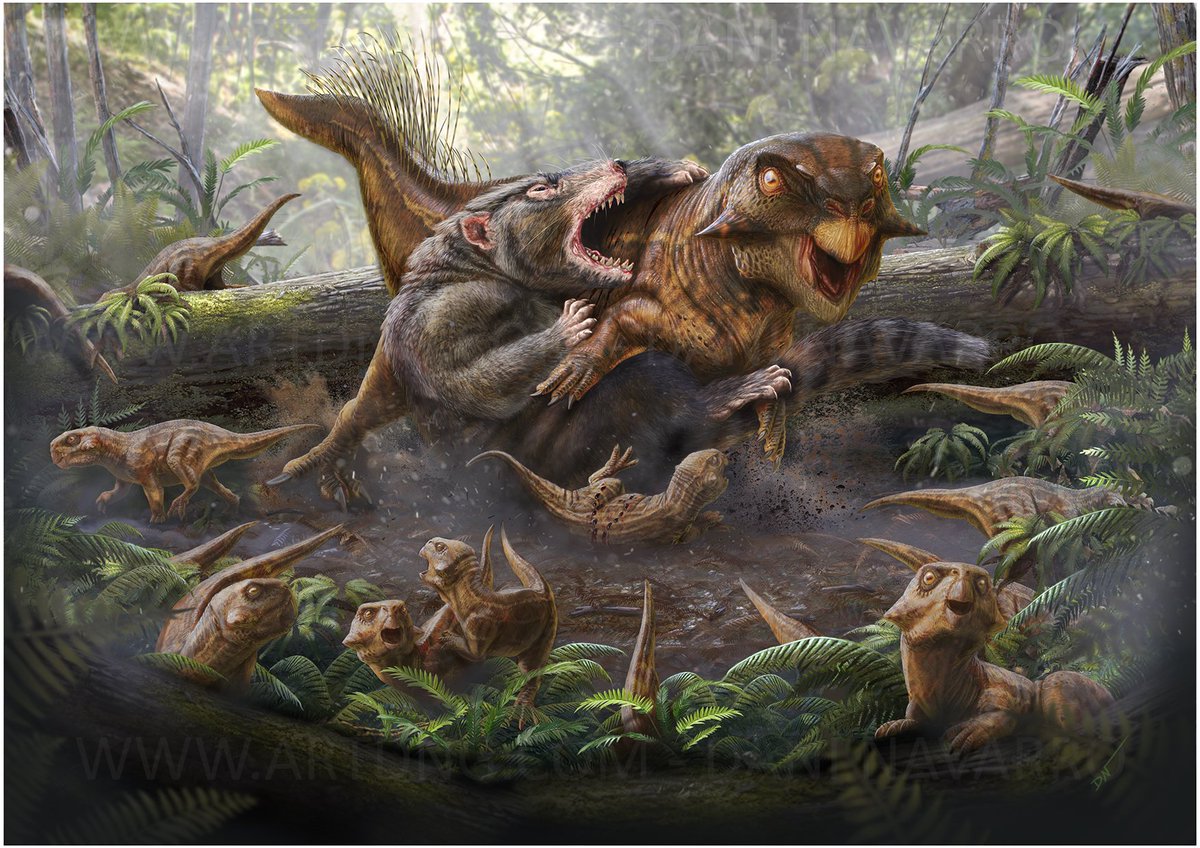The relationship between mammals and dinosaurs has always been presented as a one-sided affair: giant and ferocious dinosaurs dominated their tiny mammalian counterparts with complete authority. Seems cut and dry, right?
Unfortunately for the dinosaurs, a new discovery proves this wasn’t always the case.
On July 18th, 2023, the spectacular fossil of a horned dinosaur and mammal locked in combat was revealed to the public. Published in Nature by a team of paleontologists from the Canadian Museum of Nature, the specimen captures a predatory mammal, Repenomamus robustus, launching its assault against the larger dinosaur Psittacosaurus. To say the fossil is incredible really undersells it:

This is the most excited I’ve been about a fossil since Spinosaurus’ tail in 2020!
There’s a lol to unpack, so let’s start with the obvious: was Repenomamus hunting the Psittacosaurus, or merely scavenging it? The mammal was positioned atop the dinosaur, suggesting an active hunt instead of scavenging[i]. The hand of Repenomamus is lodged inside the dinosaur’s mouth, which could indicate that Psittacosaurus bit the predator to defend itself. This behaviour has been observed in other horned dinosaurs; the infamous “fighting dinosaurs,” a fossil of Protoceratops locked in combat with Velociraptor, features the raptor’s hand inside the mouth of Protoceratops. Clearly, their beaks weren’t only used for snapping twigs!
The scavenging hypothesis is credible as well. The fact that Repenomamus is biting the dinosaurs’ ribs seems odd for an active hunt, given that this wouldn’t have been a vulnerable area[ii]. The massive size discrepancy between the two organisms also points towards scavenging, as Psittacosaurus was over 3x larger than its mammalian predator.

While there is credible evidence on both sides, I believe the fossil represents an active hunt. The study’s authors have pointed out that the subadult Psittacosaurus may have been weakened, enabling the Repenomamus to attack regardless of the size difference. Repenomamus has been likened to wolverines, animals that have been documented taking on much larger prey like Caribou and Moose in weakened states[iii]. It has been suggested that the Repenomamus went so far as to eat the poor Psittacosaurus alive; talk about a vicious predator!
This isn’t the first time Repenomamus has been found hunting Psittacosaurus.A complete specimen of Repenomamus discovered in 2005 was found to have a baby Psittacosaurus in its stomach[iv]. What’s interesting is that this Repenomamus represents a second species, Repenomamus giganticus, which was much larger than the R. robustus found duelling the Psittacosaurus. Clearly, the small ceratopsian was a favourite meal for these ferocious mammals!

The specimen hails from the 125-million-year-old rocks of the Yixian Formation in northeastern China, a region famous for its volcanic activity during the Cretaceous. The volcanism, which has preserved thousands of feathered animals, appears to have been the cause of the animal’s sudden preservation. Shortly after the Repenomamus attacked the Psittacosaurus, both animals were quickly buried by a volcanic flow, capturing the moment for eternity.
Surprisingly, similar interactions between ceratopsians and predators have been documented before. As mentioned, the infamous Fighting Dinosaurs specimen features a very similar interaction between Protoceratops and Velociraptor, though their interaction was fossilized by sandstorms in the Gobi Desert instead of volcanic debris:

Another specimen, the Duelling Dinosaurs, features an adult Triceratops battling a juvenile T. rex. This fossil is still being prepared and researched, so its secrets are yet to be revealed. However, these three specimens exhibit a pattern of ceratopsians being hunted by smaller predators. Whether this was a legitimate ecological trend or just a bizarre coincidence is unknown. Regardless, all three of these fossils are amongst the most spectacular in the fossil record and have provided intimate glimpses of prehistory that are rarely preserved.
Thank you for reading this article! While Psittacosaurus may have been bullied by smaller mammals, it is still one of the most important dinosaurs known to science. For more information about it, I suggest you read “Meet Psittacosaurus: the Dinosaur that Keeps on Giving”, here at Max’s Blogosaurus!
I do not take credit for any image found in this article. Header image courtesy of Dani Navarro, whose terrific work can be found at their website here.
Works Cited:
[i] Han, Gang, et al. “An Extraordinary Fossil Captures the Struggle for Existence during the Mesozoic.” Scientific Reports, vol. 13, no. 1, 2023, https://doi.org/10.1038/s41598-023-37545-8.
[ii] Hone, David, et al. “New Evidence for a Trophic Relationship between the Dinosaurs Velociraptor and Protoceratops.” Palaeogeography, Palaeoclimatology, Palaeoecology, vol. 291, no. 3–4, 2010, pp. 488–492, https://doi.org/10.1016/j.palaeo.2010.03.028.
[iii] Magoun, Audrey J., et al. “Predation on Caribou (Rangifer Tarandus) by Wolverines (Gulo Gulo) after Long Pursuits.” The Canadian Field-Naturalist, vol. 132, no. 4, 2019, pp. 382–385, https://doi.org/10.22621/cfn.v132i4.2050.
[iv] Hu, Yaoming, et al. “Large Mesozoic Mammals Fed on Young Dinosaurs.” Nature, vol. 433, no. 7022, 2005, pp. 149–152, https://doi.org/10.1038/nature03102.

2 replies on “The Fighting Dinosaurs Part 3: Mammals vs Dinosaurs”
[…] preserved for all eternity by the sporadic volcanic activity of Cretaceous China. (Read “The Fighting Dinosaurs Part 3: Mammals vs Dinosaurs” for more […]
LikeLike
[…] how its species and relatives fit into the ecosystem around them. With continued discoveries of incredible specimens illustrating dinosaur behaviour, one can only wonder what is […]
LikeLike